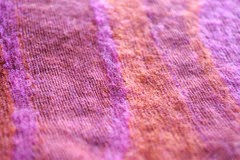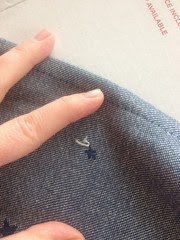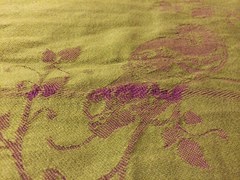Welcome to the babywearing world. If this is your first wrap purchase or your 50th, I'm sure that number is low for some as well, this will help you when you get a wrap new or from the swap to tell you what is in a expected normal range for a wrap and what is unsafe.
Woven wraps are simply a long piece of fabric that is used to wrap your baby to your body if you need more help with what carries or carrier is best for you please take a look here: http://www.marsupial-mamas.com/blogs/news/12033953-woven-wraps-all-the-sizes-which-carry-is-best-for-which-which-will-work-best-for-me. There are different ways to wrap your baby and different types of wovens on the market.
Woven wraps again are pieces of fabric that come in all sorts of sizes and blends. Cotton, Linen, Silk, Wool, Cashmere, Alpaca, Bamboo, Hemp and just recently Fox. All wraps have a certain way to wash, this can also vary by company and blend. What one company says to do with a 100% cotton may not be what another company says to do with their 100% cotton. Please, Please read the care instructions and follow them. Some wraps are sent to you in what is called "Loom State" this is when the fabric is fresh off of the loom, and woven, but unfinished. Washing on hot when in "Loom State" removes any starches used on the fibers during the weaving process and sets any rogue dye. Shrinking occurs only during the first washing, manufacturers do cut extra length. After this first washing the wrap would have also shrunk to the correct size.
These are some basic ways to wash but please follow instruction from the manufactures.
Please note: Natibaby has on their written instructions to use powder detergents.
This is because in Poland their liquids contain fabric softener. It is recommended to use liquid detergents that contain no dye, perfumes and no optical brightners.
Cotton: Cold or warm, low spin, hang to dry or tumble dry on low.
Wool: The primary concern with wool is to avoid felting it, which can weaken the fabric and potentially make it unsafe for use. To avoid this, gently hand wash your wool wraps with a wool wash without lanolin. To remove excess water after washing, lay the wrap flat in a large towel and then roll the towel up to soak up excess water. Air dry your woolie, but make sure to give it support while it is drying. I like to lay mine flat to dry to prevent stretching, night time is great time to do this so no one walks on it. The following are some examples of wool that is felted. Felting happens if it is not properly washed. The wrap will become dry and brittle. You will notice fuzzies all over the wrap as well. Also, you may possible hear creaking while pulling or wrapping with the wrap. This is a safety issue and can no longer be worn.
Hemp: Hemp is dense and fibrous. It is and incredibly strong, durable fabric. If you want your hemp wraps to be buttery soft, you will need to break down the hemp fibers (because lets face it, that's what breaking in a wrap is--breaking down the fibers). Heat is going to do that. Many people prefer to wash in warm or hot water and tumble dry on warm or high heat. I do dry my hemp on medium heat and then remove it when damp to air dry. A good steam ironing will also help the breaking in process. Hemp is one of the few fibers that can take the heat and hold up remarkably well. You do not need to wash in warm water or do a warm tumble dry to break hemp in, but the heat is going to hasten the process without the typical wear.
Please use common sense when washing and drying your hemp wraps. A wash and dry on warm is what we recommend for hemp wraps; please do not throw your hemp wrap in the dryer on the hottest setting and dry it for several hours. Hemp is dense and fibrous, but using excess heat can potentially damage the fibers in your wrap.
Please use common sense when washing and drying your hemp wraps. A wash and dry on warm is what we recommend for hemp wraps; please do not throw your hemp wrap in the dryer on the hottest setting and dry it for several hours. Hemp is dense and fibrous, but using excess heat can potentially damage the fibers in your wrap.
Linen: Cold to warm, low spin, tumble on low until damp and then steam iron.
Silk: Silk does require gentle care. It should be hand washed in cool water or on your washing machine's delicate or silk cycle, although I do strongly recommend hand washing. Silk wraps should be hung to dry. To fluff them up, you can put them in the dryer and tumble on a no heat setting for 5 minutes.
Bamboo: Bamboo is prone to shrinkage, so it's recommended that bamboo blend wraps be hand washed in cold water. It is suggested that you hang the wrap to dry and then fluff it in the dryer for 5-10 minutes on a setting with no heat.
Silk: Silk does require gentle care. It should be hand washed in cool water or on your washing machine's delicate or silk cycle, although I do strongly recommend hand washing. Silk wraps should be hung to dry. To fluff them up, you can put them in the dryer and tumble on a no heat setting for 5 minutes.
Bamboo: Bamboo is prone to shrinkage, so it's recommended that bamboo blend wraps be hand washed in cold water. It is suggested that you hang the wrap to dry and then fluff it in the dryer for 5-10 minutes on a setting with no heat.
------------------------------------------------------------------------------------------------------------
The following are some issues you may see on your woven wrap. If you have any questions or concerns, you can always email us here at Marsupial-Mamas for more help.
What is a snub or a nub?
A snub or a nub is thickening of the thread in certain areas. This is not a safety issue and is very common in hemp, linen and handwoven wraps, but don't count out cotton to have some as well. This is not a flaw and is consider normal in the woven wrap world.
This is one small snub/nub:
This is a slightly larger area of thicker threads, again normal:
What is a weavers knot?
A weavers knot is where the manufacture attach the thread ends together during the weaving process. Thread is not unlimited and does run out during the weaving process. This is how the weavers continue weaving the wrap, they just tie a knot and continue on. These are very common in all woven wraps. This is not a flaw and should be expected. Most will tighten up with a warm wash and will never been seen again after the first wash.
What is a pulled thread?
A pulled thread is a thread that has become unbound from the weave of the wrap. This is not a safety issue but can become a broken thread (explained below) if not fixed before wearing. A pulled thread can be caused by the smallest thing, how you store your wraps, washing them, wearing them, and even wrapping with them. Yes, while I was wrapping up my son, I snagged my wrap with my wedding ring. A pulled thread can be fixed, some easier then others. For smaller pulls you can gently pull in opposite directions of the pull (same way as the pull but pull out towards both sides of the wrap). Give it a nice warm bath when done. If it is a larger pull, here is a great tutorial to help you fix it:http://www.thebabywearer.com/forum/showthread.php?251947-repairing-pulls-(pic-heavy)
What is a broken thread?
A broken thread is when that pulled thread gets pulled to its max and breaks. A broken thread is not a safety issues, unless you have a group of broken threads in one area and it has become a hole. A broken thread can and should be fixed before wearing. Please follow this link to help you fix a broken thread:http://www.thebabywearer.com/forum/showthread.php?403478-Fixing-a-Broken-Thread-Tute...
If you have a patch of broken threads, like the following please do not wear the wrap until the proper fixing has been done. This is a safety issue. If you receive a wrap like this, please contact the seller/vendor before washing or wearing. ALWAYS, inspect your wrap upon receiving.
What is thread shifting?
Thread shifting is where an area of the tread "shift". This can make a weak spot in the wrap or create a gap. Thread shifting is very common in thinner wraps or wraps that have a loose weave. Thread shifting is fixable. You can take a sewing needle and use it to gently slide the threads straight back in their correct lines, gently pulling diagonally to edge them back in straight. Then warm wash, tumble dry and iron. If it is left not fixed, it will become a safety issues over time as the threads are weak in that area and will not hold up weight in that area.
What is a skipped thread?
A skipped thread happens during the weaving process. This is more of a cosmetic flaw and more times then not wraps with this issue are considered seconds. This could be overlooked very easily by both the manufacture and/or the vendor. This is not a safety issue.
What is a crease/fold?
A crease line or a fold line is not a flaw or a safety issue. These can become a problem over time if not properly taken care of. Crease lines can lead to thread shifting. How to prevent these are to iron your wraps often and not to store then braided over a long period of time. Creases/fold line will often be found along your rails. In the following photo you will notice the crease/fold line up towards the top of the photo.
Why is my middle marker not in the middle? Is this a flaw?
This is not a flaw. Middle markers can be off from a half an inch to inches. Manufactures cut the wraps longer to account for shrinkage during the first wash. They run plenty of test to see how much length will be lost but this can still vary. They do their best to place the tag as close to the middle as possible.
How do I measure my wrap?
Measuring your wrap is best done with a soft tape measure and in hand. In hand and with a soft tape measure gives you more of an accurate measurement because while measuring you are measuring the wrap in the accordance with the fibers natural stretch.
What is this thread sticking out of my hem?
It most likely is a loose thread that got caught up in the overlock under the folded hem. It is not a safety issue, as it is still sewn into the wrap. Assuming the hem is still solid it's nothing to worry about.
Why is there a white mark under my middle marker?
These white marks are made by tailor chalk. This is how the tailors mark where the middle markers belongs on the wrap. Not all companies use tailor chalk. This is not a safety issue and will wash out.
Here are a few more reminders in the babywearing world:
-Never use scissors or any other sharp object to open your package when you receive it in the mail.
-Always look your carrier over before you wash or wear. This is so very important!!
-Do not wash your wrap if you believe there is a problem or you have a concern with the wrap.
-When listing a wrap on any swap page, always disclose all of the above mention items. Whether its small to you, it may be big to someone else. This will protect you as the seller.
-If you have a safety flaw, contact either the vendor/manufacture/seller before publicly posting. If the transaction happened on a swap, contact the seller first. If cant be resolved between both parties, please contact the admin of that group.
Thank you to everyone who sent Marsupial-Mamas, LLC their photos to be used in this blog. We love and adore your support you show us.
written by Jilliane - March 24, 2014





















Comments
Post a Comment